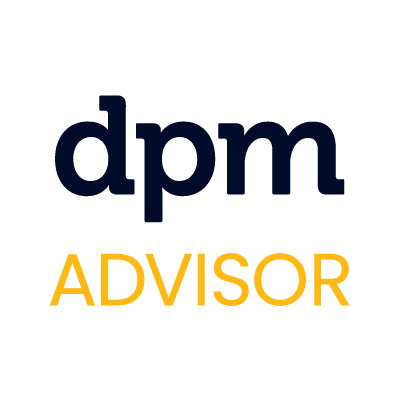Imagine trying to build a house without a blueprint or setting off on a road trip without a map. That’s exactly what it would feel like to manage a project without first creating a project plan.
A detailed project plan is essential to helping teams stay aligned and on track throughout a project. These important documents typically outline things like project budget, resources, timeline, deliverables, and more. Without one, misalignments in project scope and objectives are inevitable—along with project failure.
That’s why it’s so important to get your project plan right from the start. Often, that means using project management software to get everyone aligned and ready to move forward.
What Is A Project Plan?
A project plan is a document that outlines the project scope, project objectives, and project schedule. It serves as a road map for all project stakeholders by providing clear direction and expectations.
A good project plan will provide clarity on:
- What needs to be done
- When it needs to be done by
- Who is responsible for each project task
It will help ensure that everyone involved in the project understands their role and how their work fits into the bigger picture of the overall goal.
Watch our TL;DR here:
Why Are Project Plans Important?
Project plans are probably the single most important piece of project documentation you’ll create.
The benefits of project planning include:
- Stronger communication: The project planning process allows you to set expectations with stakeholders and team members from the outset about things like status update frequency, meeting schedules, and response times for emails and messages. It will also ensure there is agreement on the all-important live date.
- Less rework: Project plans should also define a project’s outputs and project scope, leading to less rework throughout. If you and your team understand your objectives in advance, it will help to guide your decision-making and task completion throughout the project.
- Better resource management: Project plans enable you to visualize the entire project and see the interdependencies between tasks. This will help with resource management by showing you who will be doing what task when, and forecasting your resource requirements.
- Improved risk management: Part of the planning process involves brainstorming risks or issues that could arise on your project. You'll be aware of these in advance, so you can protect your project by coming up with mitigation plans. Project plans also outline milestones and timeframes, allowing you to make sure your project is progressing properly.
- Higher-quality projects: During project planning, you'll define the metrics that will determine whether the project is successful. You'll have a goal to work towards throughout the project, and you'll know immediately upon completion whether your efforts were successful.
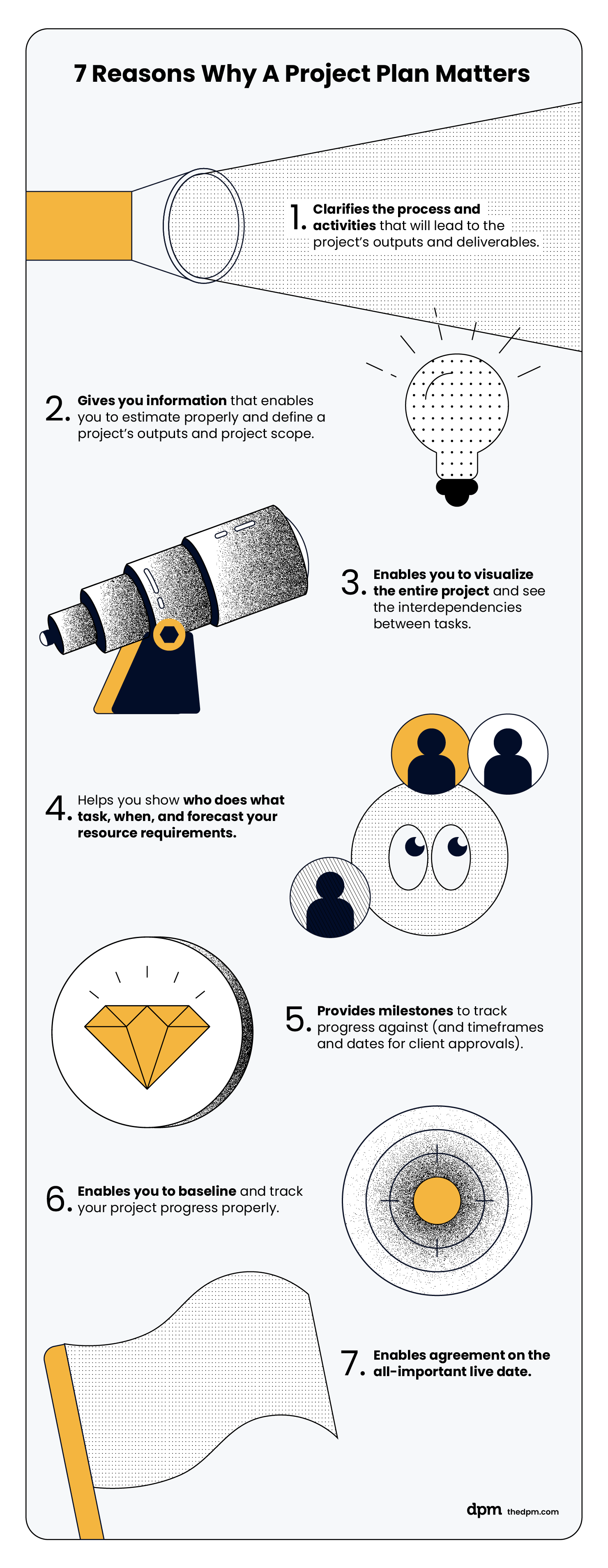
Step-by-Step Guide on How To Make a Project Plan
Here are 8 steps to writing a project plan:
- Step 1: Gather Important Project Info
- Step 2: Define the Project Scope
- Step 3: Understand Your Available Resources
- Step 4: Outline Project Structure and Phases
- Step 5: Create a Project Schedule
- Step 6: Develop a Communication Plan
- Step 7: Make a Plan for When Things Go Wrong
- Step 8: Share Your Plan and Collect Feedback
Step 1: Gather Important Project Info
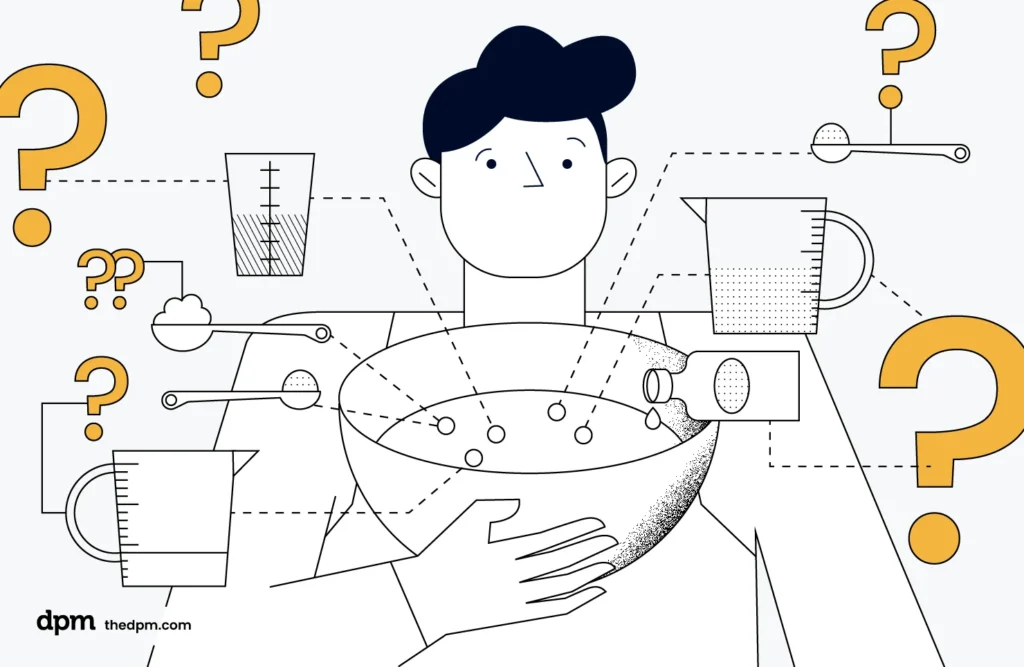
Before you start your project plan, you need to be clear on the:
- Why? The project’s strategic goals.
- What? The activities (or process), outputs, and project deliverables.
- When? The deadlines and dependencies.
- How? The process or methodology.
- Who? The client and their team of stakeholders.
Usually, a good project kickoff meeting will help you collect this information. You should also consult the project charter and/or statement of work (SOW).
Step 2: Define the Project Scope
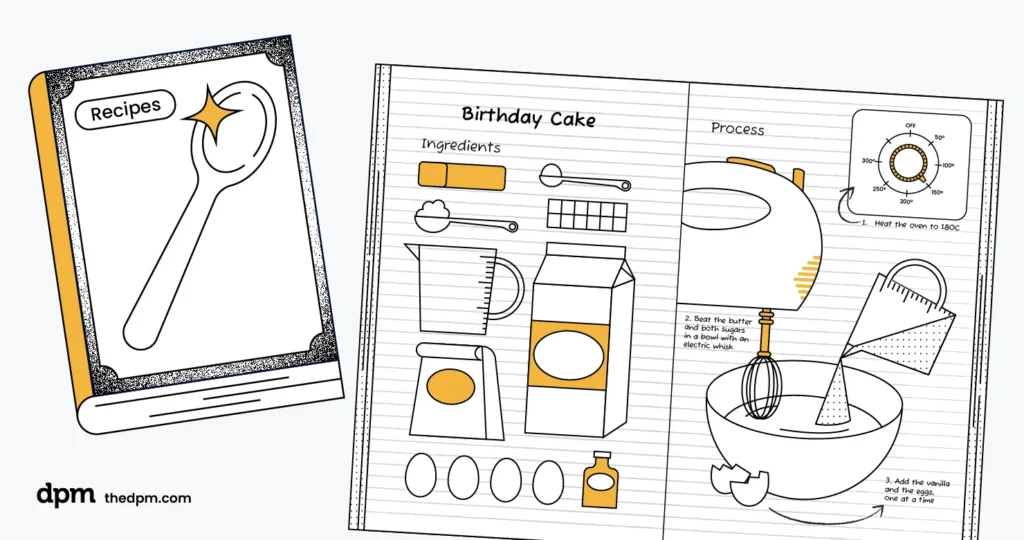
One of the most important parts of developing a project plan is making sure the project scope has been clearly defined. Your project scope is basically the work you’re agreeing to deliver. It can also encompass the project boundaries, limitations, and assumptions.
To define your project scope, start by identifying the objectives of your project—what do you aim to achieve, and what are the expected deliverables? Then, focus on the boundaries, including what won’t be included in the project. This will help to prevent scope creep.
By clearly defining your project’s objectives and purpose, you’re establishing the groundwork for your project plan.
Most project management software allows you to create a detailed project description, set objectives, and outline deliverables within a project plan or a dedicated project scope section. Monday.com, for example, allows you to create a project with distinct sections for scope and objectives, where you can also attach files and links for detailed requirements.
Step 3: Understand Your Available Resources
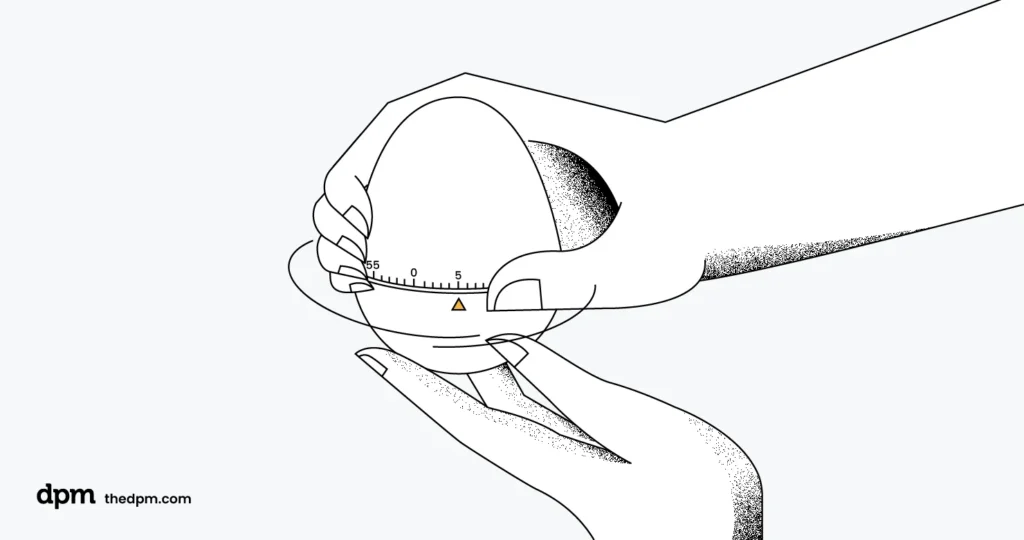
Before you can dive into creating a project schedule or laying out specific tasks, you need to understand the resources available to you. Your resources are the people, tools, and budget you’ll have to complete the deliverables outlined in your project scope.
If you don’t already have one, you should create a detailed budget that outlines the financial resources required for the project. Determine the estimated costs for each deliverable, and allocate additional funds for unexpected expenses. Using resource management software can be really helpful in creating budget forecasts and monitoring spending in real-time throughout the project.
As part of your project plan, you can also create a RACI chart to help you clarify roles and responsibilities on your team. This will allow you to visualize how each of your team members will fit into the overall project.
Step 4: Outline Project Structure and Phases
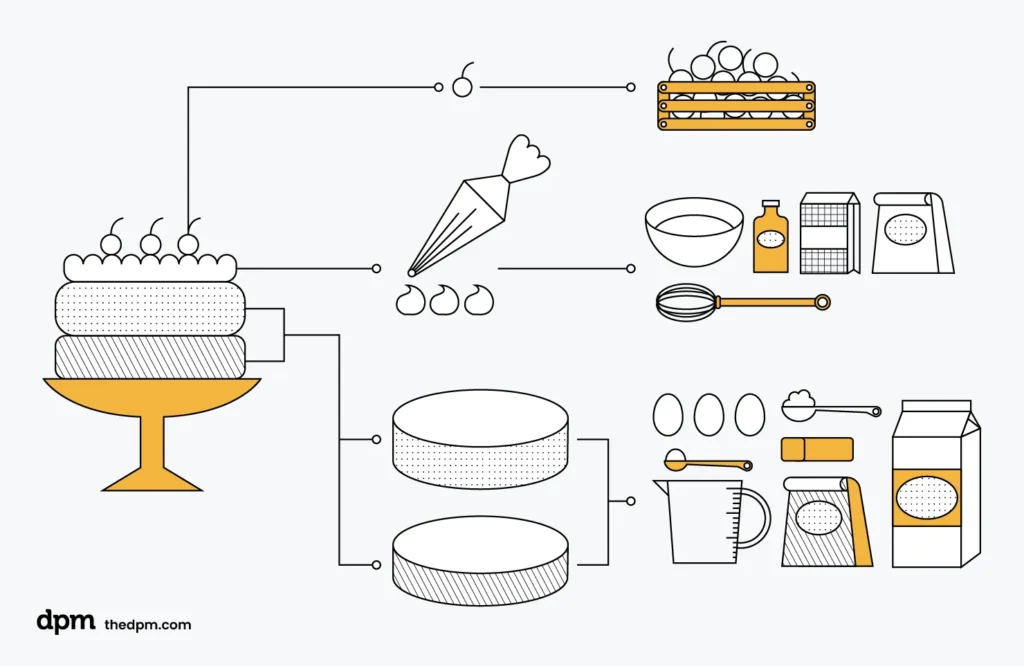
When creating a project plan, the temptation can sometimes be to dive straight into your project planning tool or project management tool and add in all the tasks that need to get done.
But before you add in specific tasks and project milestones, make sure you get the overall project structure right. This means first defining the workflow and what the different phases of the project will be.
Make a rough plan. Sketch out the overall flow of your project from initiation to completion. Map out each project phase and the likely activities and tasks required in each part of the project to complete the project.
Step 5: Create a Project Schedule
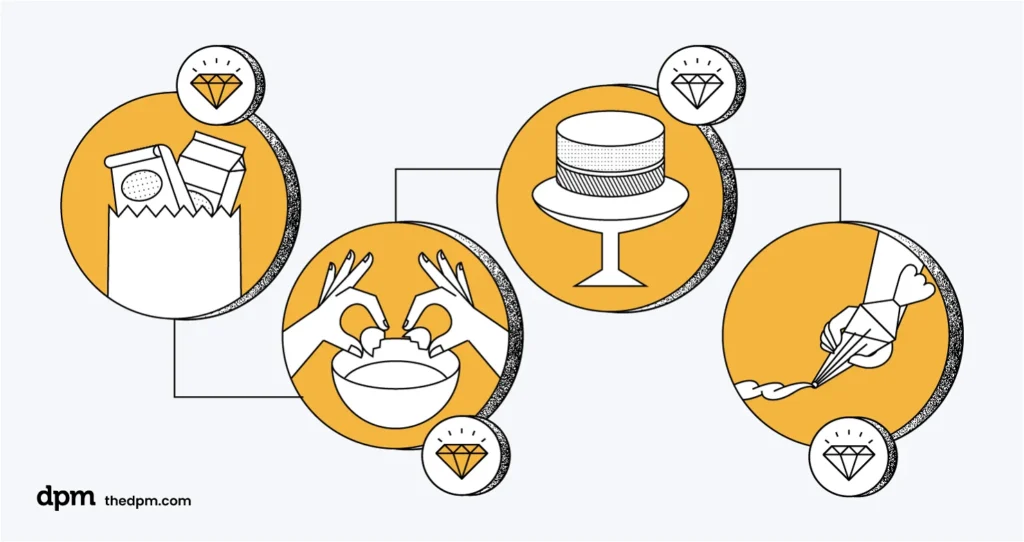
Based on your scope, available resources, and project structure, you can start to solidify the timeline for your project.
One thing that can be helpful for creating your project schedule is to create a work breakdown structure (WBS). This will help you narrow down the project into smaller, more manageable components, and organize the various tasks and responsibilities of your team. To develop a WBS, start by dividing each major deliverable into smaller tasks and sub-tasks. Then, allocate tasks to different team members or departments. With each deliverable, you should also set key milestones to ensure timely completion.
With a better understanding of your deliverables, you can create a detailed project schedule that outlines the timeline for each task and milestone. Gantt charts can be incredibly useful for visualizing the project timeline.
Collaborate with your team to share assumptions, dependencies, and work out who can do what, when. This will help you get as close to a realistic timeline as possible for your project. Keep in mind that it also may not be feasible to plan out the whole project in detail. In that case, create a project schedule in detail only for what you know, or for the phase that you’re in, and make allowances for the rest of the project.
Step 6: Develop a Communication Plan
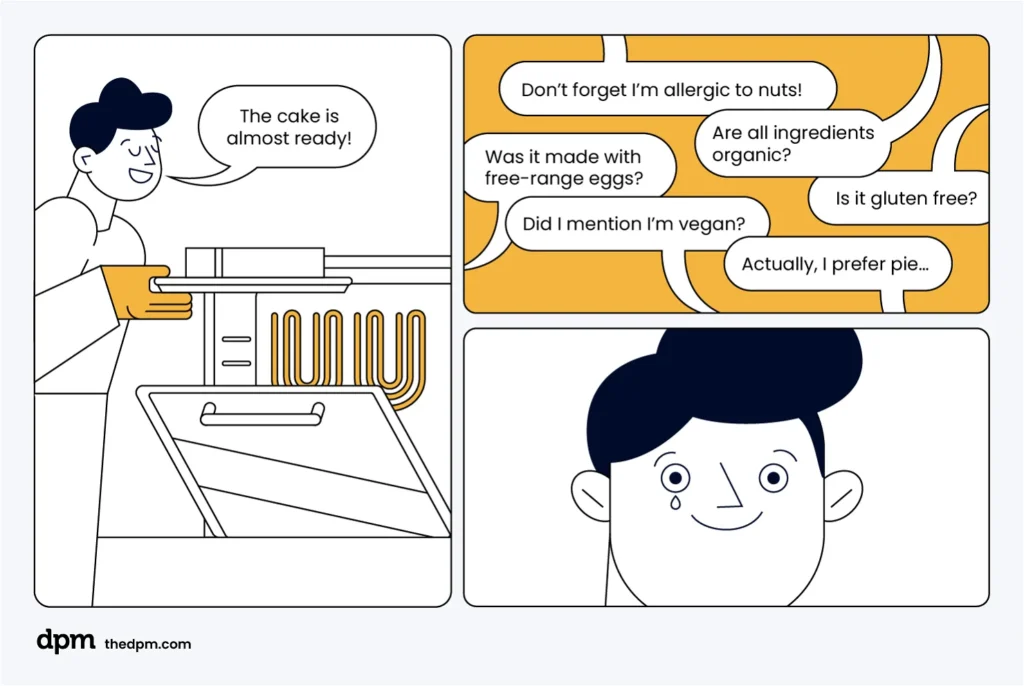
Your project plan should also outline the approach you’ll take to communicating with stakeholders throughout the project. How will you track progress, share updates, and take feedback?
One easy way to make sure communication is seamless throughout your project is to rely on a collaborative project management tool. Most PM software makes it easy to collaborate on documents, comment on tasks, provide feedback, and share updates.
In your communication plan, you should also specify the methods (meetings, emails, reports, etc.) you’ll use to share information, and how often stakeholders can expect check-ins.
Step 7: Make a Plan for When Things Go Wrong

Projects rarely go as planned. Simply planning for the best case scenario or Plan A, isn’t good enough—you need to bake in Plan A, Plan B, and Plan C into your project plan.
First, identify potential risks that could negatively impact the project. Then, evaluate the likelihood and impact of each of these risks, and develop strategies to minimize them. What alternative approaches can you prepare ahead of time to ensure the project will follow the timeline you’ve outlined?
You should also plan ahead for potential changes to the project. No matter how closely you think you’re aligned with your client on a project, you need to prepare for changes. Make sure you bake in extra time for review and change cycles, both internally and with clients.
Step 8: Share Your Plan and Collect Feedback

At this point, you should have a pretty robust project plan. It’s time to share it with your stakeholders. Ask for their feedback and make necessary revisions based on their input. Once you get final approval, you can start implementing. As you begin executing the project according to the plan, don’t forget to continuously monitor your progress and make adjustments as needed.
What Does a Project Plan Look Like?
Project plans can be as simple as a scribble on the back of a napkin or a few lines in Excel, but it’s usually presented as a roadmap or Gantt chart, made in Smartsheet, Microsoft Project, or a similar alternative to MS Project.
Your Gantt chart or project timeline might also be part of a larger written document that includes sections like an executive summary or scope statement (Gantt chart makers are handy for creating these charts).
Specific file formats might include Excel spreadsheets or a Google Sheet, as well as a Word Document, Google Doc, or PDF.
What Should A Project Plan Include?
A project plan typically includes:
- Project Phases
- Activities, Tasks, and Project Deliverables
- Task Start Dates and End Dates
- Task Dependencies
- Milestones and Baselines
- Project Scope Statement
- List of Requirements
- Risk Assessment
- Project Budget
- Metrics & KPIs
1. Project Phases
What phases are required to complete the entire project? Note: this is different from the phases in the project life cycle, which aren’t specific to any one project type.
The phases you’ll need to include in your project plan are the ones specific to the workflow of the project you’re working on (what you’ll complete in the project execution phase of the life cycle).
This also may depend on which methodology your project will follow, such as agile, Kanban, or waterfall.
2. Activities, Tasks, & Project Deliverables
Once you have your phases set, break them down into smaller tasks. It’s important to work with the project team that will be completing the work here, as they are more familiar with exactly what’s involved in designing a website page.
You might break down the website design phase (for a simple website) into the following sub-tasks:
- Design the navigation
- Design the homepage
- Design the about page
- Design the contact page
- Design the product pages
- Etc.
3. Task Start Dates & End Dates
For each task that you defined in the last step, set a start date and end date. This might depend on a variety of factors—when your team members are available, how long it takes to get feedback from the client, or if there are any tasks that need to be completed before a specific task can start (see next step).
4. Task Dependencies
Make a note of which tasks depend on others to be completed before they can start. These are known as task dependencies. One example of a dependency is that in order to start coding the homepage, you need to prioritize designing the homepage first.
It’s also worth defining the project’s critical path. This is the order of activities that represents the longest path in a project, and determines how quickly the project can be completed.
Once you know which tasks depend on others, you can order them according to their dependencies. The amount of time it takes to complete those tasks in that order is your project timeline. Tasks that don’t depend on others can be completed amongst the tasks on the critical path, without affecting the timeframe.
5. Milestones & Baselines
Project milestones are smaller project goals or checkpoints throughout the project, and can be used to keep track of project progress and report on project status. Each one should have a due date.
Your milestones might line up with the phases determined earlier, with certain approvals from project stakeholders or project sponsors, or some other element of your project.
6. Project Scope Statement
A scope statement denotes what exactly you’ll deliver, as well as what you won’t (what’s out of scope). You should also note any assumptions you’re making, as well constraints or limitations.
Having this in an easy-to-reference place for both team members and clients will also help avoid scope creep.
7. List of Requirements
Include a list of all the project’s requirements, which you should have gathered in the requirements gathering stage, starting before the formal project planning process begins. Depending on the type of project, you might have technical requirements, functional requirements, non-functional requirements, or other kinds of requirements.
8. Risk Assessment
Assessing risk is an important part of the planning phase. Usually, project managers use RAID logs or risk registers to keep track of potential risks and their risk management plans for each one. Keep a copy of this near or within your project plan.
9. Project Budget
Include notes on the agreed-upon cost of the project or project estimate. Throughout the project, track progress against the budget—are you running over or under?
10. Metrics & KPIs
How will you know that you’ve reached the successful completion of the project? What does project success look like? Be sure to define these metrics using KPIs.
Best Practices for Implementing and Adjusting Your Project Plan
Before you dive in, remember these important points about project plans:
- A project plan should be much more than a roadmap. To give a client a complete view of a project, it should be combined with an estimate and a statement of work too.
- Proper project planning isn’t difficult, but it does take time. And it’s not a one-time thing. You create a plan and then continually refine it.
- Get more out of your project plan by presenting it. Turn your plan into a presentation for clients so that they can better understand the limitations and scope of the project. It’ll also help them understand if the proposed work will deliver what they want and if the process you’re proposing will get the results they’re paying for.
- Pair it with a communication plan. A communication plan covers how often status reports will be updated, meetings cadence, or which channels a particular stakeholder prefers to communicate through.
- Consult your project charter, statement of work, and/or project initiation document (PID). You likely don't need all of these for your project. The charter outlines the key elements needed to move the project forward, the SOW specifies requirements and timelines, and the PID is often a higher-level version of the project plan.
- Adapt to changes. This is especially true if you're following one of the agile methodologies. Reassess your plan at key phases of the project, when you receive feedback that requires a change in direction, or as needed.
- Consider resource allocation. While you might not know your exact project team when you create your plan, it's a good idea to start thinking about who might work on what (potentially using a RACI chart) and check their availability and current workload. This will help avoid situations where you try to assign a task and the team member you need is on vacation.
- Analyze past project plans. Review old project plans that you or your peers created to see what worked and what didn't. This is a way to get insights on whether a timeline or budget is realistic, or whether you might be missing requirements or phases in your next project plan.
- Don’t forget to include post-project reviews. Going live isn’t the end of the project. Build a phase into the project plan for post-live testing and analysis to measure performance, make any optimizations required, and take note of all lessons learned.
Find project planning techniques to help you out here.
Expert-Recommended Tools for Project Plan Creation
Project management software speeds up the project planning process. Instead of existing in a document somewhere on the server that no one will refer back to, it can exist in a software tool that can be updated by anyone on the team in real time, and everyone will get notifications about changes.
Here's a list of the best project management software to consider:
Consider using collaboration tools in conjunction with project management software (which usually include built-in collaboration features) so the project team can chat about tasks and collaborate as needed.
Sample Project Plan Template With Timeline [Download]
One of the easiest ways to learn how to make a project plan is to look at an example.
Our project management expert team has created a simple project plan template for a website project that’s way better than just a blank Gantt chart template (which you can find anywhere!).
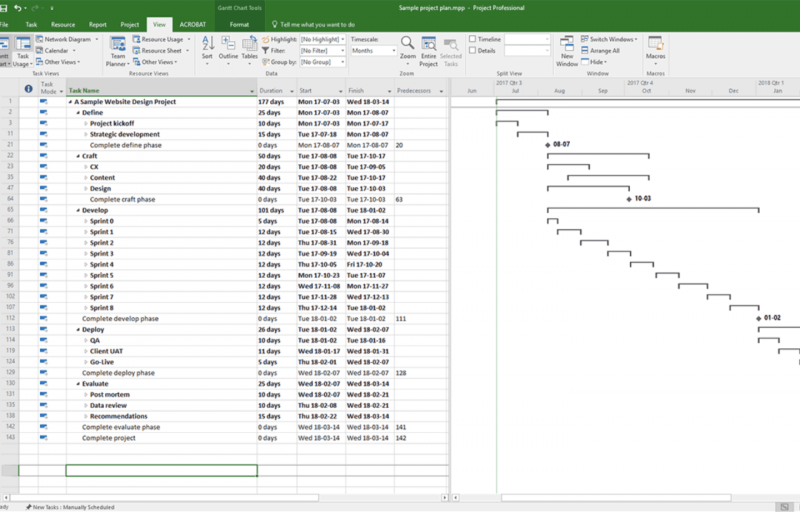
Looking for more templates for project documentation? Join membership and get access to 100+ templates, examples, and samples. Plus, get access to our Slack community and join the conversation with 1000's of other digital project managers!
Need expert help selecting the right Project Management Software?
If you’re struggling to choose the right software, let us help you. Just share your needs in the form below and you’ll get free access to our dedicated software advisors who match and connect you with the best vendors for your needs.



